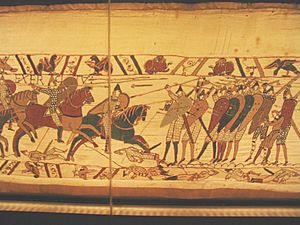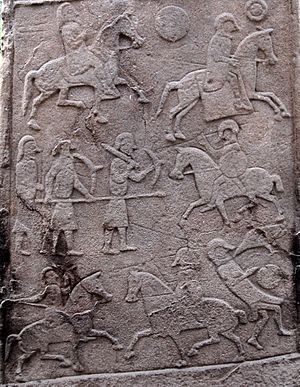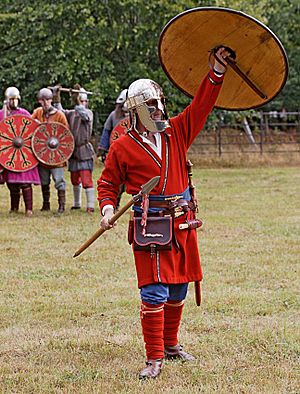Anglo-Saxon warfare facts for kids
Anglo-Saxon warfare describes how people fought battles in Anglo-Saxon England. This period lasted from the 5th century AD to the 11th century. The fighting styles and weapons were similar to those used in other parts of Europe during the Early Medieval Period. However, Anglo-Saxons usually fought on foot, unlike some other Germanic groups like the Franks.
Contents
How Do We Know About Anglo-Saxon Warfare?
Historians learn about Anglo-Saxon warfare from two main sources:
- Archaeology: Many weapons have been found in graves from the early Anglo-Saxon period. This shows us what kind of weapons they used.
- Written Records: Later Anglo-Saxon writings, mostly by Christian monks, mention battles. These writings don't focus on fighting details, but they give us clues. For example, Bede's Ecclesiastical History of the English People talks about different battles.
Because the written records are limited, experts also look at texts from neighboring groups. These include writings from the Franks, Goths, and later Viking sources. It's important to remember that Anglo-Saxon society changed a lot over these centuries. It started as small groups and grew into a single kingdom. So, warfare also changed over time.
Battlefield Tactics: How They Fought
We have some descriptions of Anglo-Saxon battles. Two important poems tell us about the Battle of Brunanburh (937 AD) and the Battle of Maldon (991 AD). These poems often mention javelins, spears, and swords. Archery is mentioned less often.
What Was the Shieldwall?

A common battle tactic was the shieldwall. Both sides would form lines, holding their shields close together. This created a strong wall to protect them from thrown weapons. They would stand just out of reach of each other.
Here's how a typical shieldwall fight might have happened:
- Getting Ready: Armies would line up. Leaders would give inspiring speeches to their warriors.
- Moving Closer: A loud battle cry would be shouted. One or both shieldwalls would then move forward.
- Throwing Weapons: Both sides would throw arrows, javelins, axes, and rocks. The goal was to weaken the enemy's courage.
- Shield to Shield: One side would close the small gap and attack. They used spears and swords. Warriors would protect themselves with shields and push to try and break the enemy line. If neither side broke, they might pull back to rest. Then they would throw more weapons and close in again. This continued until one line broke. This could happen if a leader died or a banner was captured.
- Running Away and Chasing: One side would start to give up and flee. Some might make a final stand, like at Maldon. But most would run away. The winners would chase them, killing those they could catch.
How Did Warriors Fight Individually?
Sometimes, individual warriors would run forward from their lines. They did this to get more power for their javelin throws. This was risky because they left the safety of the shieldwall. They could be hit by an enemy's thrown weapon.
If a warrior was killed in the space between the shieldwalls, someone might rush out. They would try to grab valuable armor and weapons from the body. This included extra javelins, swords, and shields. The person who threw the fatal javelin was often in the best position to do this. Running out like this, especially to get gear, showed great bravery. It could also bring a warrior wealth and improve their standing as a retainer.
Because these javelin duels were so visible, some detailed descriptions have survived. They tell us about the throws and the fights over fallen warriors' belongings.
Experts like Richard Underwood have studied how spears were used. They suggest two main ways:
- Overarm: Held high with the arm extended, pointing downwards. This was good for attacking over an enemy's shield, aiming for the head or neck.
- Underarm: Held along the forearm. This was more for defense. It was good for blocking enemy spears and pushing against shields. It wasn't as useful for attacking.
Sometimes, individuals or small groups would fight with swords over bodies between the shieldwalls. Ideally, enough damage would be done by thrown weapons. This would make any shield-to-shield fighting easier. At close range, swords and shields were preferred over thrusting spears. Shields were also used to push opponents. This created gaps in the shieldwall, leaving enemies open to attack. Hacking through shields was a common tactic. So, a strong sword arm and a good sword were very helpful.
Horses in Anglo-Saxon Warfare

Anglo-Saxon writings often mention warriors having horses. Some early Anglo-Saxon graves even include horse burials. By the later period, much of the army might have traveled to war on horseback.
However, there is little proof that horses were used in actual battles. They were mostly used to chase a defeated enemy. The Aberlemno 2 stone might show Northumbrian cavalry fighting Picts. Also, the Repton stone shows a mounted warrior ready to fight.
After the Normans conquered England, many Anglo-Saxon warriors joined the Varangian Guard. This was a special group of soldiers for the Byzantine emperors. They were so many Anglo-Saxons that the guard became known as the "English-Varangians." In 1081, at the Battle of Dyrrachion, Emperor Alexios I ordered the Varangians to get off their horses and march. This shows Anglo-Saxons rode to battle but then fought on foot.
Supplying the Army
We don't know much about how Anglo-Saxon armies got their supplies. Smaller armies could find food as they traveled. But larger armies needed an organized way to get food and equipment. It's possible that soldiers brought their own food. There is also some evidence that pack horses, led by grooms, carried supplies.
Sometimes, a fleet of ships and an army worked together. This happened during the reign of Athelstan against the Scots. It also happened in the 11th century in Wales. It's likely that the ships helped carry supplies, similar to later medieval wars in those areas.
Training for War
Understanding how battles were fought helps us see why certain sports were important. Being good at sports like running, jumping, throwing spears, and wrestling were key skills for a warrior. Heroes like the legendary Beowulf were known for being champions in these athletic events.
See Also
Primary Sources
- Anglo-Saxon Chronicle
- The Battle of Maldon
- The Battle of Brunanburh
- Finnsburh fragment


